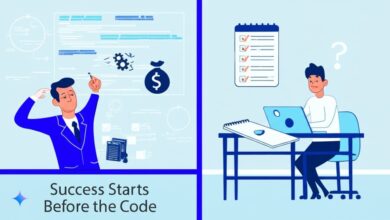
Have you ever poured your heart into building a product only to discover nobody wants it?
I’ve been there.
The excitement of a new idea, followed by months of coding, designing, and planning—only to launch to crickets.
Creating a successful Minimum Viable Product isn’t about perfection. It’s about finding signal through the noise.
Key Takeaways:
- Focus on solving one painful problem extremely well
- Launch quickly with imperfect solutions to gather real feedback
- Prioritize retention and willingness to pay over vanity metrics
What Is an MVP, Really?
An MVP isn’t a half-baked version of your grand vision. It’s a strategic experiment designed to validate your core hypothesis with minimal resources.
Many founders misunderstand this concept. They build watered-down versions of their dream product, complete with unnecessary features and polish.
My experience taught me something different. Users don’t care about your beautiful UI if you’re not solving a genuine problem in their lives.
The 10 Commandments of a Successful MVP
1. Solve One Painful Problem
Focus on addressing a single, significant pain point. Nothing more.
When Dropbox launched, they didn’t try to reinvent file management. They solved one excruciating problem: syncing files across devices without emailing attachments to yourself.
Ask yourself: “What keeps my potential users awake at night?” Then address that specific nightmare.
2. Deliver One Clear Outcome
Your MVP should promise and deliver one concrete result.
Buffer started with a simple premise: schedule tweets in advance. Not analytics, not multi-platform posting, just scheduling tweets. This clarity made their value proposition immediately obvious.
Users should be able to explain what your product does in a single sentence.
3. Skip Logins, Dashboards, Integrations
Authentication systems, complex dashboards, and integrations with other services eat development time without proving your core value.
According to a study by First Round Capital, technical founders spend nearly 40% of early development time on features that don’t directly validate their main hypothesis.
Start without user accounts if possible. Use magic links or simple passwords. Save the OAuth implementation for later.
4. Use Duct Tape Behind the Scenes
Manual processes aren’t scaling failures—they’re learning opportunities.
Zapier’s co-founders individually set up integrations for early customers. They connected services manually before building their automation platform.
Don’t hesitate to use spreadsheets, manual data entry, or Wizard-of-Oz techniques while validating demand.
5. Fake It If Needed — But Capture Real Feedback
Simulation can save months of development while providing genuine insights.
Before building complex AI, send queries to human experts behind the scenes. Before creating a marketplace, curate offerings manually.
A Stanford research paper showed that 75% of successful startups pivoted based on feedback from simulated features in their MVPs.
| Approach | Development Time | Feedback Quality | Risk |
|---|---|---|---|
| Full Implementation | Months | High | Very High |
| Simulated Features | Days | High | Low |
| Mockup Only | Hours | Medium | Very Low |
Whatever you fake, ensure you capture authentic feedback about the value proposition.
6. Validate That Someone Would Pay
Downloads, sign-ups, and compliments don’t pay the bills.
Make sure your MVP validates willingness to pay, not just interest. This might mean pre-selling access, charging a small fee from day one, or explicitly discussing pricing with early users.
According to Y Combinator, startups that charged from their MVP stage had 34% higher survival rates after two years.
7. Launch Ugly
Perfection is the enemy of progress. Launch with the minimum design needed for functionality.
Craigslist built a multi-billion dollar business with a design that barely changed since the 1990s. They focused on solving real problems instead of visual appeal.
Ship your product when you feel slightly embarrassed by it. That’s usually the right time.
8. Talk to Users Daily
Data tells you what happened, but conversations explain why.
Set up systems to speak with users regularly. This might mean:
- Calendar slots dedicated to user calls
- Regular surveys with open-ended questions
- Community forums where you actively participate
These conversations provide insights no analytics dashboard ever could.
9. Track Retention, Not Just Downloads
Initial excitement fades quickly. What matters is whether people keep coming back.
Focus on activation (completing key actions) and retention (returning regularly) metrics rather than vanity numbers like downloads or registered users.
A study published in Harvard Business Review found that a 5% increase in customer retention can increase profits by 25-95%.
10. Iterate on Pain, Not Preference
Users will request countless features. Prioritize changes that address genuine pain points, not mere preferences.
When early Facebook users complained about the lack of privacy controls, Zuckerberg recognized this as a critical pain point, not just a preference. He prioritized those features accordingly.
Ask: “Would users abandon the product without this change?” If not, it’s probably a preference rather than a pain point.
Final Thoughts
Building an effective MVP isn’t about cutting corners, but about finding the shortest path to validated learning.
Keep focused on the ultimate purpose: if your product isn’t helping someone survive, save time/money, or succeed in meaningful ways, it’s probably not a true MVP.
The best MVPs might look unimpressive but deliver tremendous value.
They answer fundamental questions about your business while establishing relationships with early adopters who forgive imperfection in exchange for solving their real problems.
What’s your next MVP going to focus on solving?






